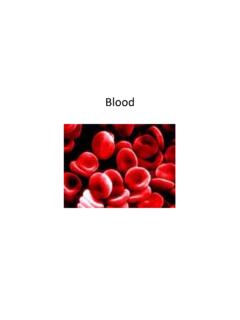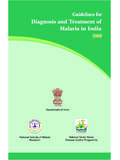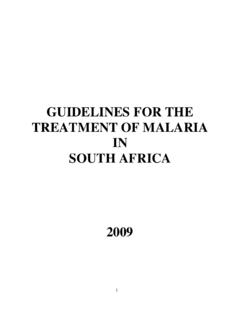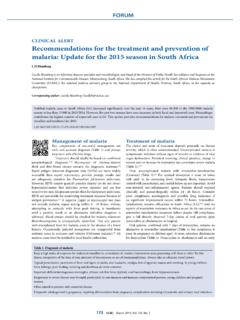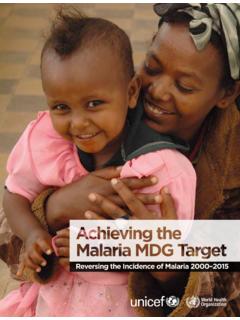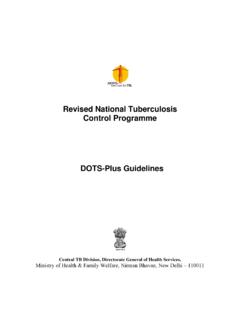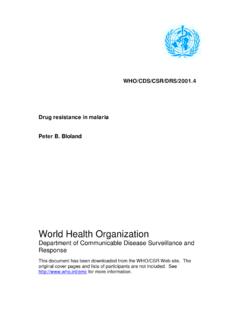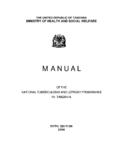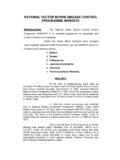Transcription of Revised National Tuberculosis Control Programme …
1 Revised National Tuberculosis Control Programme (RNTCP)Dr. NAVPREETA ssistant Prof., Deptt. of Community MedicineGMCH ChandigarhProblem Statement of TB in India India accounts for nearly 1/4th of global burden of TB (2010). Mortality: 26 per 1 lac population. Prevalence (old + new cases): 256 per 1 lac population. Incidence (new cases only): 185 per 1 lac Development Goals Goal 6: Combat HIV/AIDS, malaria and other diseases Target 8: By 2015, to have halted and begun to reverse the incidence of malaria and other major Indicator 23: between 1990 and 2015 to halve prevalence of TB disease and deaths due to TB Indicator 24: to detect 70% of new infectious cases and to successfully treat 85% of detected sputum positive patients Evolution of TB Control in India1950s 60sImportant TB research at TRC and NTI1962 National TB Programme (NTP)1992 Programme Review only 30% of patients diagnosed.
2 Of these, only 30% treated successfully1993 RNTCP pilot began1998 RNTCP scale up 2000 >30% of country covered 2004>80% of country covered 2006 Entire country covered by RNTCPN ational Tuberculosis Control Programme NTCP was started in 1962 with aim to detect cases at the earliest & treat them. However, treatment success rate : unacceptably low Death & default rate : highNeed For Revised Startegy in 1992, nation wise review was conducted with assistance of SIDA & WHO. NTP suffered from managerial weakness Inadequate funding Over reliance on X rays for diagnosis Frequent interrupted supplies of drugs Low rates of treatment completion. In 1993, GoI decided to give a new thrust by revitalizing NTP.
3 RNTCP thus formulatedRevised National Tuberculosis Control Programme Objectives of RNTCP: 1. To achieve and maintain a cure rate of at least 85% among newly detected infectious (new sputum smear positive) cases2. To achieve and maintain detection of at least 70% of such cases in the strategy:1. Augmentation of organizational support at centre and state Use sputum testing as primary method of diagnosis3. Standardized treatment regimen4. Ensuring regular, uninterrupted supply of drugs5. Emphasis on training, IEC, operational research & NGO Increased budget outlayComponents of DOTS:1. Political will ensures financial support and Case detection with the help of quality assured sputum smear Regular and uninterrupted supply of drugs patient wise boxes 4.
4 Directly observed treatment direct observation while patient is getting Systemic monitoring and of RNTCP at State levelState TB CellDistrict TB CentreTuberculosis UnitMicroscopy CentreDOT CentreSTO, Deputy STOMO, Accountant, IEC Officer, SA, DEODTO, MO-DTC, LT, DEO, DriverMO-TCSTS, STLSMO, LTDOT Provider MPW, NGO, PP, Comm VolNodal point for TB controlOne/ 5 lakh ( lakh in hilly/ difficult/ tribal area)One/ lakh ( lakh in hilly/ difficult/ tribal area)Recommendation of the RNTCP National Laboratory Committee (Oct 2008) Strongly recommended that RNTCP changes diagnostic criteria of Smear +ve PTB as below: TB suspect is any person with cough for 2 weeks, or more Number of specimen required for diagnosis is 2, with one of them being a morning sputum One specimen positive out of the two is enough to declare a patient as Sm+ PTBB asis of changes The Revised definition of a new sputum smear positive pulmonary TB case is based on the presence of at least one acid fast bacillus (AFB) in at least one sputum sample in countries with a well functioning EQA system.
5 The reduction of the number of specimens to be examined for screening of TB cases from three to two, in places where workload is very high and human resources are CategoriesTreatmen t groupsType of patientRegimenIntensive phase (IP)Continuation phase (CP)New (Cat I) New sputum smear positive New sputum smear negative New extra pulmonary New others2H3R3Z3E34H3R3 Previously treated (Cat II) Smear positive relapse Smear positive failure Smear positive treatment after default Others 2H3R3Z3E3 S3/1H3R3Z3E35H3R3E3 Quality Assurance RNTCP Lab network has three levels: National Reference Laboratories NTI Bangalore TRC Chennai LRS New Delhi Intermediate Reference Laboratories State level Network of Designated Microscopy Centers(>11,000)
6 Includes microscopy centers in medical colleges One DMC covers a population of about 1 lakh Provide quality assured acid fast sputum smear microscopy servicesRNTCP External Quality AssessmentComponents Panel testing On site evaluation Random blinded rechecking of routine slidesExternal Quality Assessment activities of RNTCPR eporting ProcedureHIV & TB HIV co infection strongest known risk factor for the progression of latent TB infection to active TB disease Estimated 7 10% annual risk of reactivation, with 60% lifetime risk (cf. 10% lifetime risk in TB infected, non HIV infected individual) Conversely, TB amongst the most common causes of morbidity and mortality in people living with HIV/AIDS Immune response to TB bacilli increases HIV replication leading to a rapid progression of HIV disease Optimal access to DOTS will significantly reduce morbidity and mortality in PLWHATB/HIV collaborative activities TB/HIV Action Plan implemented by RNTCP and NACP jointly, focusing on: Training of service providers Service delivery linkages (ICTC RNTCP Cross referrals) Monitoring Information, Education, and Communication Implementation started.
7 In 2001, in 6 high HIV prevalent States (population 311 million) expanded in 2004, to 8 additional States (population 323 million)TB/HIV collaborating activities National , State and District level coordination committees to monitor linkages Guidelines and training material developed jointly On going training of staff on TB/HIV Cross referral between ICTC and DOTS services developed, piloted and implemented Involvement of NGOs and PPs Collaborative IEC activities Joint monitoring of activitiesTreatment of TB in HIV TB can be successfully treated even in HIV infected pts. But, cannot alone prevent people from dying of AIDS In addition to TB treatment , ART and CPT needed for those eligible DOTS is the treatment of choice Intermittent SCC is effective National policy is to provide RNTCP Cat I to new cases and Cat II to re treatment cases Higher relapse rates have been observed especially in those treated with non Rifampicin containing regimen Whether true relapse or re infection?
8 Drug interactions between Rifampicin and ARVs National policy is to start ART after completing anti TB treatment , or modify ART by replacing Nevirapine with Efavirenz for the duration of TB treatment Likely impact of HIV on TB in India? Scenario without RNTCP HIV would increase TB prevalence (by 1%), incidence (by 12%), and mortality rates (by 33%) between 1990 and 2015 Scenario with RNTCP Expect substantial reductions in prevalence (by 68%), incidence (by 41%), and mortality (by 39%) between 1990 and 2015 Nationally, RNTCP should be able to reverse the increases in TB burden due to HIV but, to ensure that TB mortality is reduced by 50% or more by 2015, HIV infected TB patients should be provided with antiretroviral therapy in addition to the recommended treatment for TBPediatric Tuberculosis Related to adult TB Can occur at any age Disease develops within one year of infection Younger, earlier = disseminated PTB : EPTB :: 55.
9 45 PTB paucibacillary, usually sp negTreatment of Pediatric TB DOTS Categorization SAME Doses per kg body weight Drugs to be made available as combi packs in patient wise boxes, linked to child's weight ( 6 10kg,11 17kg, 18 25kg,26 30kg) PWB being made available PC13 yellow (6 10kg) PC14 orange (11 17kg) Prolongation pouches Pink (18 25 kg) Gray (26 30 kg)MDR TB and DOTS Plus MDR TB is a lab diagnosis, NOT a clinical one MDR TB levels of less than 1% to 3% in new cases and of 12% in re treatment cases. Emergence of resistance to Rifampicin in only 2% of patients, despite a high level (8%) of initial resistance to Isoniazid, either alone or in combination with other anti TB Quality assured laboratory facility for culture and Drug Susceptibility Test must be available (NB: 2 4 months delay before DST results seen) RNTCP Cat IV treatment is a 24 month standardized 2nd line regimen given under daily DOT: 6 Km Ofx Eto Cs Z E / 18 Ofx Eto Cs E MDR TB patient admitted to indoor facility at DOTS Plus site for up to 1 month for: pre treatment assessment; initiation of Category IV treatment after decision of DOTS Plus site committee.
10 Monitoring tolerance to treatment regimen; counseling and health education to patient and family; developing linkages to district services; and contact tracingAchievements of RNTCP treatment success rate: 25% (1998) to 88% (2010) Death rate: 29% (1998) to 4% (2010) 662 DTCs 2,698 TUs 13,039 DMCs 1,971 NGOs > 10,894 Private practitioner 297 Medical colleges > 13,000 peripheral








